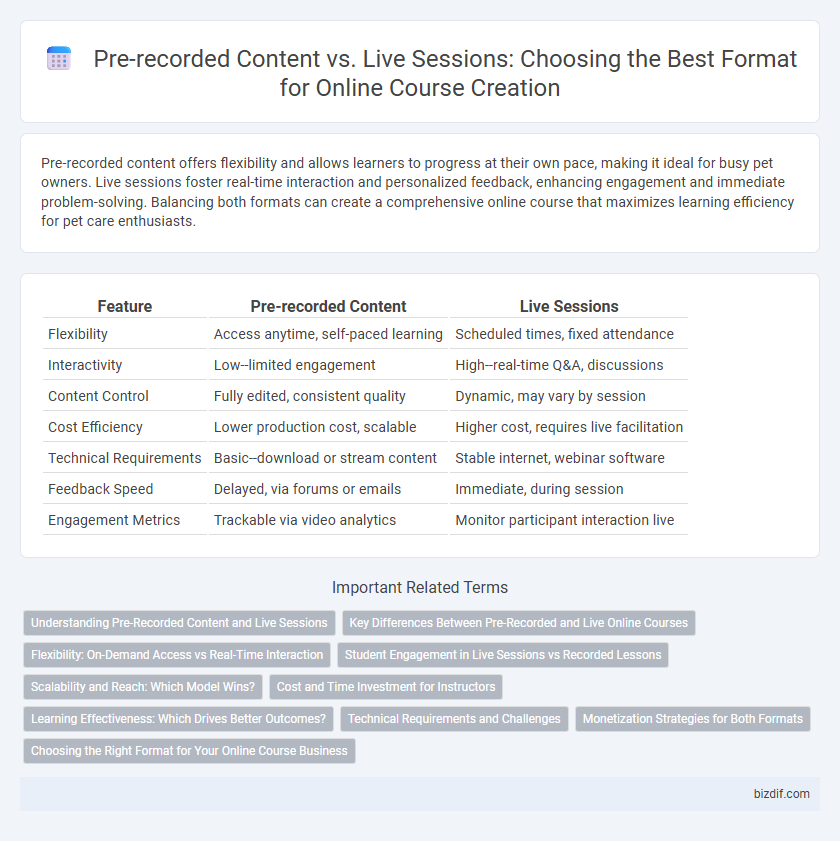Pre-recorded content offers flexibility and allows learners to progress at their own pace, making it ideal for busy pet owners. Live sessions foster real-time interaction and personalized feedback, enhancing engagement and immediate problem-solving. Balancing both formats can create a comprehensive online course that maximizes learning efficiency for pet care enthusiasts.
Table of Comparison
| Feature | Pre-recorded Content | Live Sessions |
|---|---|---|
| Flexibility | Access anytime, self-paced learning | Scheduled times, fixed attendance |
| Interactivity | Low--limited engagement | High--real-time Q&A, discussions |
| Content Control | Fully edited, consistent quality | Dynamic, may vary by session |
| Cost Efficiency | Lower production cost, scalable | Higher cost, requires live facilitation |
| Technical Requirements | Basic--download or stream content | Stable internet, webinar software |
| Feedback Speed | Delayed, via forums or emails | Immediate, during session |
| Engagement Metrics | Trackable via video analytics | Monitor participant interaction live |
Understanding Pre-Recorded Content and Live Sessions
Pre-recorded content offers learners flexibility by allowing them to access lessons anytime, enabling self-paced study and repeated review of complex topics. Live sessions foster real-time interaction, immediate feedback, and active engagement, which enhances comprehension and builds a collaborative learning environment. Combining both formats maximizes course effectiveness by catering to diverse learning preferences and improving overall knowledge retention.
Key Differences Between Pre-Recorded and Live Online Courses
Pre-recorded online courses offer flexibility and allow learners to access content anytime, enabling self-paced study with consistent quality and minimal technical issues. Live sessions provide real-time interaction, immediate feedback, and a dynamic learning environment that fosters engagement and community building. Choosing between these formats depends on the need for learner control versus interactive, synchronous communication.
Flexibility: On-Demand Access vs Real-Time Interaction
Pre-recorded content offers unparalleled flexibility through on-demand access, allowing learners to study at their own pace and revisit materials whenever needed. Live sessions enable real-time interaction, fostering immediate feedback, engagement, and collaboration between instructors and participants. Balancing these formats maximizes course adaptability, accommodating diverse learning preferences and schedules.
Student Engagement in Live Sessions vs Recorded Lessons
Live sessions drive higher student engagement by enabling real-time interaction, immediate feedback, and dynamic discussion, fostering a more immersive learning experience. Pre-recorded content offers flexibility and self-paced learning but often lacks the spontaneity and direct communication that enhance motivation and participation. Balancing live engagement with accessible recorded materials optimizes student involvement and knowledge retention in online course creation.
Scalability and Reach: Which Model Wins?
Pre-recorded content enables unlimited scalability by allowing learners to access materials anytime, anywhere, without scheduling constraints, making it ideal for global reach. Live sessions offer real-time interaction but are limited by time zones and participant capacity, restricting scalability. For expanding audience size and maximizing reach, pre-recorded courses generally outperform live sessions in online course creation.
Cost and Time Investment for Instructors
Pre-recorded content for online courses requires a significant upfront time investment to script, record, and edit, but offers scalability and minimal ongoing costs. In contrast, live sessions demand continuous time commitment for real-time interaction and scheduling, increasing the instructor's workload and limiting course delivery flexibility. Cost-wise, pre-recorded courses reduce instructor hours and enable passive income, while live sessions often incur recurring expenses related to platform fees and time-intensive preparation.
Learning Effectiveness: Which Drives Better Outcomes?
Pre-recorded content offers learners flexibility and self-paced study, enhancing retention through repeated access to materials, while live sessions foster real-time interaction and immediate feedback, which can boost engagement and clarify complex topics effectively. Research indicates a blended approach combining asynchronous videos with synchronous discussions maximizes learning outcomes by catering to diverse learning preferences and reinforcing knowledge application. The integration of interactive elements within both formats plays a critical role in driving higher comprehension and skill acquisition in online course environments.
Technical Requirements and Challenges
Pre-recorded content requires reliable video editing software, sufficient storage capacity, and high-quality recording equipment to ensure clear audio and visuals, minimizing technical glitches during playback. Live sessions demand stable high-speed internet, real-time interaction tools such as chat or polls, and robust streaming platforms capable of handling concurrent users to prevent disruptions. Both formats pose challenges in accessibility and user experience, necessitating thorough testing and technical support to maintain engagement and effective learning.
Monetization Strategies for Both Formats
Pre-recorded content enables scalable revenue through evergreen sales funnels, automated marketing, and subscription models, maximizing income with minimal ongoing effort. Live sessions drive higher engagement and premium pricing opportunities via real-time interaction, exclusive Q&A, and limited-time offers, fostering customer loyalty and upselling possibilities. Combining both formats allows course creators to optimize monetization by balancing accessibility with personalized experiences, enhancing overall profitability.
Choosing the Right Format for Your Online Course Business
Pre-recorded content offers flexibility and scalability for online course creators, allowing learners to access material at their own pace, while live sessions foster real-time interaction and engagement, enhancing the learning experience. Selecting the right format depends on your target audience's preferences, course complexity, and desired interaction level; combining both formats can maximize reach and effectiveness. Analytics on learner engagement and completion rates provide critical insights to optimize the balance between pre-recorded lessons and live sessions, boosting course completion and customer satisfaction.
Pre-recorded Content vs Live Sessions Infographic

 bizdif.com
bizdif.com